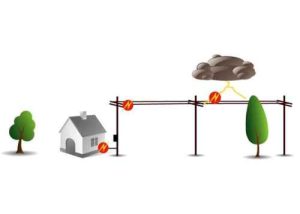Indirect lightning is the result of a direct lightning strike whose flow has not been controlled. Any lightning current, whose path is not well channeled, can take any path in a completely random manner to reach the earth, generating possible electric arcs (sparking) in its path.
Overvoltages (induced effects) appear between the arrival of the external power lines and the structure's earth equipotential system. These overvoltages “penetrate” towards the interior of the structure by propagation (along the lines). We use equipment called lightning arresters and placed on the electrical network to protect it.
What are the consequences of indirect lightning strike?
Conduction:
The overvoltage phenomenon comes from direct contact of a conductor with lightning.
The overvoltage propagates along the conductor and by extension the network.
An electrical or communications network cannot contain the devastating energy of a lightning strike.
Induction:
The overvoltage phenomenon comes from the electromagnetic field radiated by the lightning strike.
Cables, pipes, antennas and all metal masses are likely to become conductors within a perimeter proportional to the power and speed of variation of the lightning strike.
Rising from the ground:
The overvoltage phenomenon comes from the electronic effects of the direct lightning strike or by dissipation of the lightning current evacuated by the earth of the lightning rod towards the earth of the installation.
The lightning current is capable of “going up” the network via the earth.
Rises in earth potential:
The overvoltage phenomenon comes from the dispersion of current in the ground causing destructive potential differences between the masses of the equipment and the networks to which they are connected.

